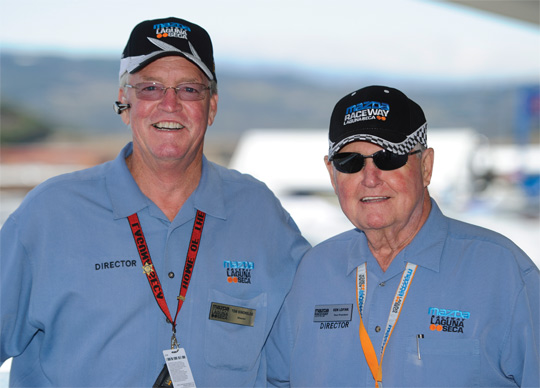
When the American Le Mans Series opens Mazda Raceway Laguna Seca’s 2012 season this May, volunteers will arrive at the track long before spectators fill the stands.
“There will be volunteers in the conference room at five in the morning, because they have to be at the gates at six. They’re strategizing and getting ticket stuff organized, and it’s still pitch black out,” says Barry Toepke, vice president of communications and historic racing at Mazda Raceway Laguna Seca. “Sometimes, you’ll see people at the gates as you come in, standing with flashlights in the fog, waiting to check passes. And they’ve got these smiles on their faces…”
Those smiling ticket takers, along with most of the concession servers, program sellers, shuttle drivers and other individuals greeting track guests, are among nearly 2,500 people who donate time during Laguna Seca events. Together, volunteers worked more than 20,000 hours in 2011 alone. Some are community members with a passion for racing. Many more belong to one of about 70 local civic and charitable groups that partner with Sports Car Racing Association of the Monterey Peninsula (SCRAMP), the 501(c)(4) organization that oversees track operations.
• May 18-20: Ferrari Racing Days
• July 27-29: Red Bull U.S. Grand Prix, featuring the MotoGP World Championship
• Aug. 17-19: Rolex Monterey Motorsports Reunion, featuring the Shelby Cobra
• Sept. 7-9: Continental Tire Sports Car Festival, featuring the Grand-Am Rolex Sports Car Series
The races and track rentals that SCRAMP manages generate about $1 million annually for the Monterey County Parks Department, and guests’ related hotel reservations, restaurant tabs and local purchases bring in millions more. In addition, SCRAMP thanks community groups that volunteer, such as the Special Olympics , Boy Scouts, Girl Scouts, Rotary and others, by donating race proceeds. Those contributions alone total nearly $12 million since racing began at Laguna Seca in 1957.
Supporters of Monterey Bay Veterans, a nonprofit that operates fishing, diving and physical rehabilitation programs for wounded and disabled veterans, have volunteered at Mazda Raceway Laguna Seca for more than two decades. On race weekends, volunteers transport disabled guests to viewing points around the track using a custom-built, wheelchair-accessible limousine golf cart. The organization has made such an impact that they’ve also been asked to provide services during golf tournaments, air shows and other major events in the area.
“One Laguna Seca guest related that he’d been coming to the races for the longest time, since before the paths were paved,” says Monterey Bay Veterans Executive Director John Whitacre. “His buddies had to carry him and his wheelchair clear up that hill, and he felt that his friends were burdened by his coming to the races with them. With our program, he can give them a ride up the hill because they ride alongside him. Now he feels important, because it’s like he’s taking care of them after so long.”
The donations that SCRAMP makes to Whitacre’s nonprofit are crucial to its operations. But the opportunity to volunteer means more than just dollars for Monterey Bay Veterans members—especially those who are disabled themselves.
“They can’t believe that they can actually go and help other people. They feel good about themselves, and they’re learning that there are people a lot worse off than they are,” says Whitacre. “They can be active members of society.”
Working beside volunteers from the Monterey Peninsula are those who travel from afar to help. One man from Idaho camps at the track for several weeks in the summer, so that he can work the paddock gate for more than one race. Another group from the San Francisco Bay Area comes down to volunteer for every major event of the season.
“It’s really about camaraderie. We are all a family when it comes to race weekends,” says Mazda Raceway Laguna Seca PR Manager Johanna Koch. “I would be lost without those guys that help in the media center. I can’t wait for the race season to start again so that I can see them.”
With events such as the Red Bull U.S. Grand Prix and its headlining MotoGP championship broadcast in more than 200 countries, volunteers fluent in foreign languages are particularly valuable. Students from Monterey’s Defense Language Institute Foreign Language Center translate for some 300 international journalists covering any given weekend. Other community volunteers have served in the media center for
as many as 30 years.
“Our volunteers feed off the activity, and they come back year after year…We learn from them what works, what doesn’t work and what to look out for,” says Toepke. He is one of about 30 full-time SCRAMP employees who collaborate with a 25-member volunteer board and 250 volunteer assistant directors to manage thousands of participating supporters. Ken Lofink, a past president of the SCRAMP
board, has been a director since 1977 and currently serves as director of hospitality. On nonevent weekends, his volunteers assist corporate groups holding events at the track. During races, they oversee hospitality rooms and pit row seats, coordinate catering and manage beverage booths. Volunteers on his team also set up infrastructure before events, and help break things down once races wrap up.
“It’s like a football game. You go to the stadium the week before and there’s nothing but the field. Then, all of a sudden, you have a major event like the MotoGP or the Rolex Reunion, and it becomes a small city,” Lofink says. “Having done this for 36 years, you’d think I’d get tired. But actually, I enjoy every race. I find it rewarding.”
Race administrators say that events simply couldn’t happen without the dedication of so many enthusiastic volunteers.
“Without the support and manpower [of our volunteers], much of this facility would just cease to exist. We are a world-class race track, but we’re still a boutique-type facility,” Toepke says. “It’s a special place, and it really does hold a special magic for so many people.”
For more information on events at Mazda Raceway Laguna Seca, go towww.mazdaraceway.com.